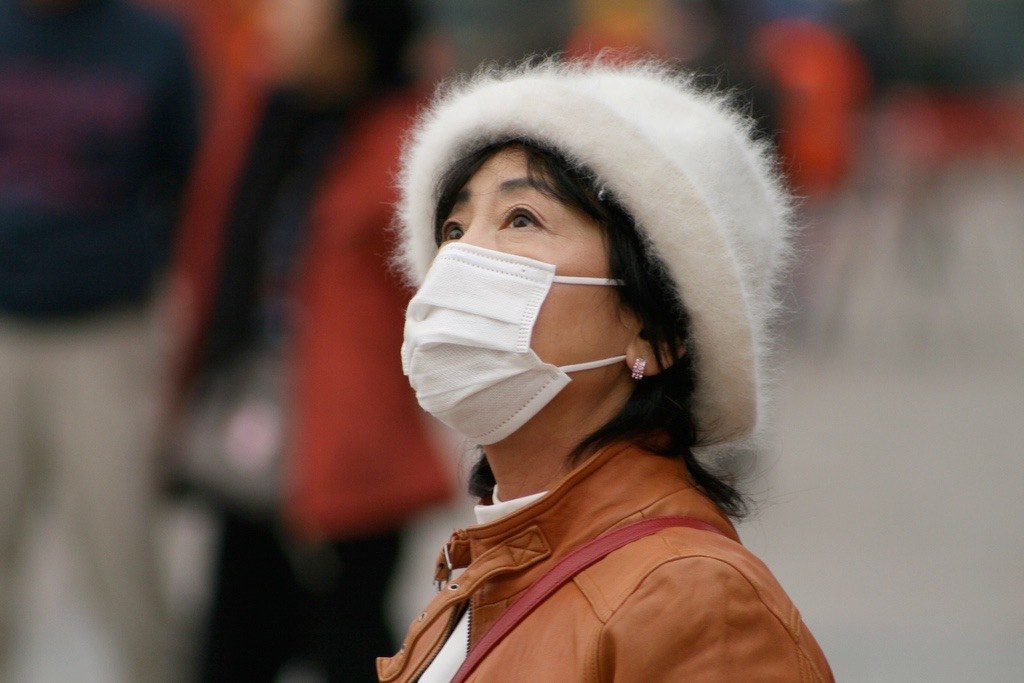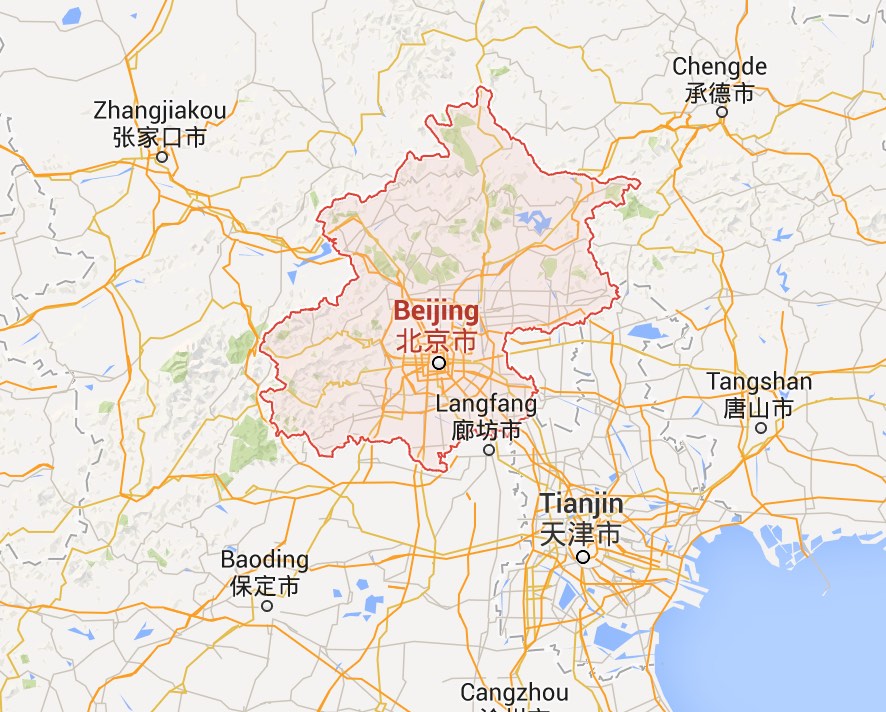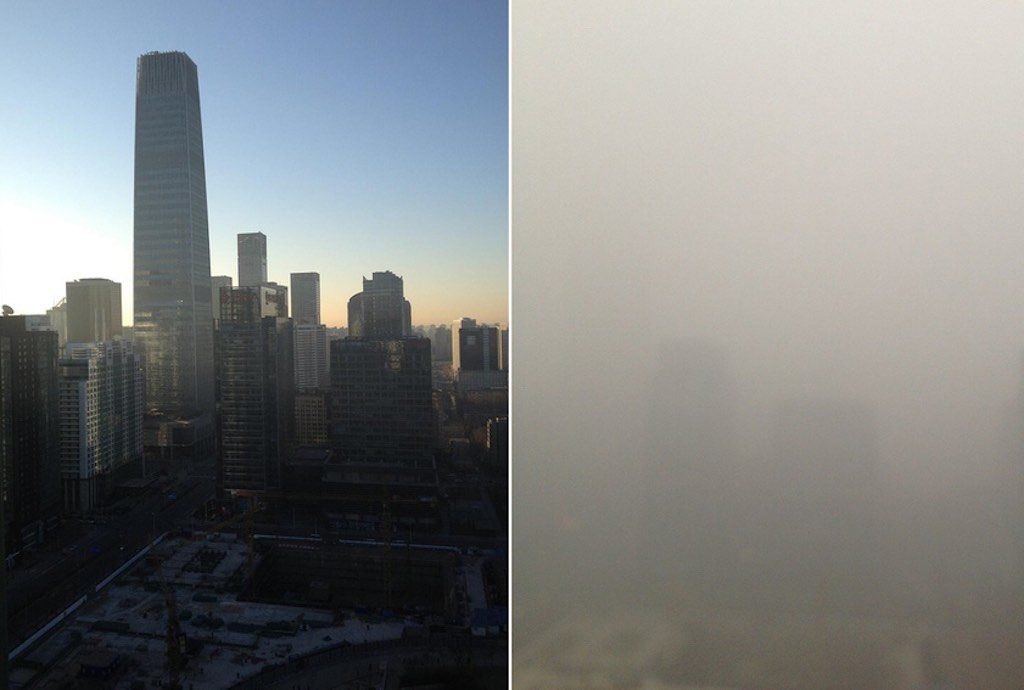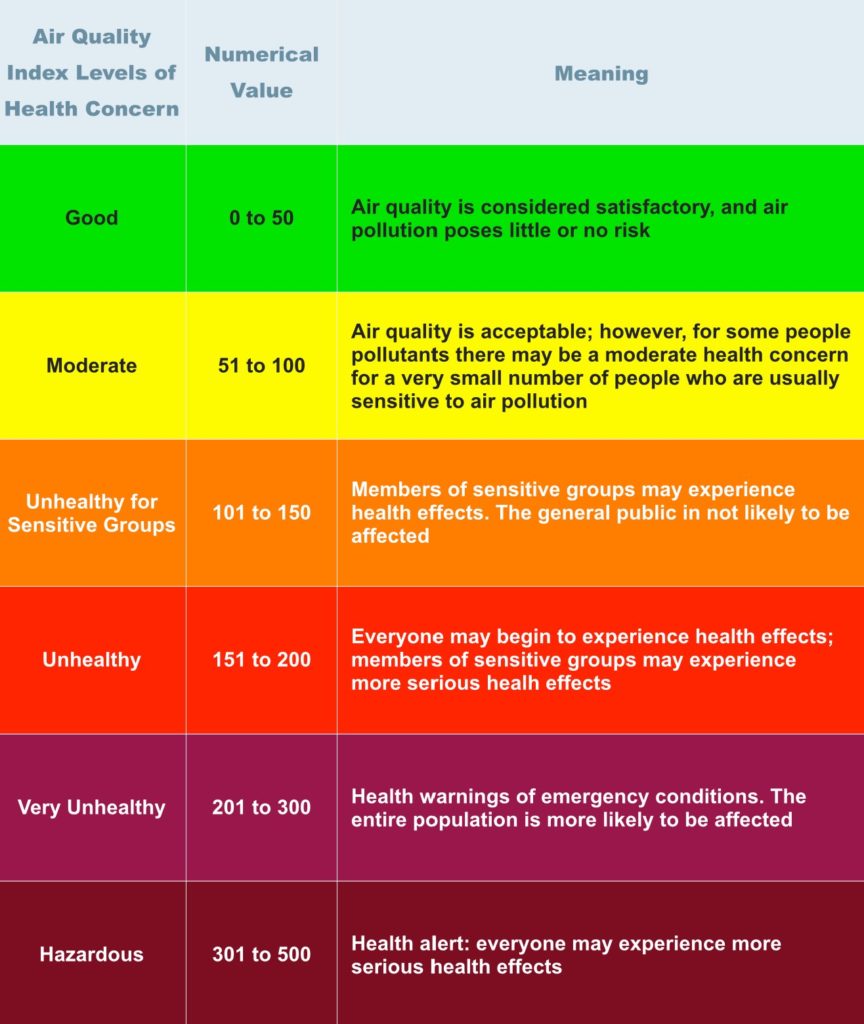Pollution
4.2 Causes and Consequences of Air Pollution in Beijing, China
Mason F. Ye
Beijing, China suffers from some of the worst air pollution worldwide. What is the source of this air pollution? How has the poor air quality affected the people and the surrounding environment?

Photograph by Nicolò Lazzati, 2009. CC BY 2.0.
China is notorious for being a major polluter. Its economic growth in the past three decades has been the fastest among major nations, which is the main factor in why China has extensive air pollution. Of the twenty cities with the worst air pollution worldwide, 16 are located in China, including Beijing.1,2,3 Due to this extensive air pollution, China’s Environmental Sustainability Index is ranked near the bottom among countries worldwide.2
The causes of Beijing’s widespread air pollution can be attributed to a number of factors: an enormous economic boom, a surge in the number of motorized vehicles, population growth, output from manufacturing, and natural reasons which include the city’s surrounding topography and seasonal weather. China has also experienced major economic growth with a drastic rise in Gross Domestic Product (GDP). This increase in wealth can be correlated with an increase in pollution.

Beijing, the capital of China, is located in the northeast corner of the country.
Map data ©2015 Google. Public Domain.
Click Here to Explore Beijing, China in Google Maps
With this amplified wealth, individuals are more capable of affording motor vehicles.1,4,5,6 The number of motor vehicles on Beijing’s roads has doubled to 3.3 million with nearly 1200 added each day. Emissions from motorized vehicles contribute to nearly 70% of the city’s air pollution. The four most dangerous pollutants that are emitted include: sulfur dioxide (SO2), nitrogen dioxide (NO2), carbon monoxide (CO), and particulate matter (e.g. PM10).3 Newly introduced vehicles have lower emission standards, and thereby emit more of these pollutants into the atmosphere than their older counterparts. Motorized vehicles are only one contributor to air pollution. Population growth in China and Beijing contributes to extensive pollution. Beijing’s population has swelled from 11 million to 16 million in just 7 years, and has doubled over the past century.1,3
Coal burning factories also contribute to the smog present in Beijing. These factories rely on outdated and inefficient technologies. The factories are located on the outskirts of Beijing and the nearby cities of Harbin and Hebei.1 Beijing is a victim of its own topography because it is surrounded by mountains, ensuring that pollution remains trapped within the city limits.5 Air quality worsens in spring and summer when temperature and humidity levels rise, and winds contribute to the smog by carrying pollutants from industrialized southern regions.3 There are a variety of consequences of air pollution in Beijing. Along with health consequences, high levels of harmful emissions have led to hundreds of flight cancellations and frequent road closures due to low visibility levels.7 Air pollution has increased substantially over the years, resulting in thick smog that often engulfs the entire city6 (Figure 3).

(Left) Beijing on a clear day.
(Right) Beijing in February, 2013 from the same view when Beijing was experiencing dangerously poor air quality.
Photograph by Bill Bishop, 2013. CC BY-NC 2.0.
Air pollution is measured by the Air Quality Index (AQI), which scales pollution levels from 0 to 500 and assigns a color to different number levels to measure how hazardous the air quality is on any given day (Figure 4). Levels of 100 or below are known as “Blue Sky Days”, when smog is not easily visible.3,5,7 However, levels now reach up to 755, as measured by the United States Embassy in Beijing, which employs its own pollution reading device. This is the highest level of air pollution since recording began in 2008, and was appropriately deemed “Beyond Index”. The World Health Organization suggests that scores near 500 contain more than twenty times the safe level of particulate matter in the air.5

Adapted from U.S. Environmental Protection Agency, 2015. Public Domain.
Emissions and contaminants may also be carried across the Pacific Ocean to the Western United States by powerful global winds called Westerlies. Though this pollution is created by Chinese manufacturing and export of goods, it is demand for these goods in the United that fuels production. The United States is ironically causing its own environmental degradation through trade with China.1,8
The shorter lifespans of Beijing’s citizens has been connected to high pollution levels.7,8 Compared to citizens living in southern China, the average life span for Beijing’s citizens is five to six years shorter. The air pollution in Beijing causes lower birth rates and higher adult mortality from respiratory related diseases. Lung cancer rates have risen over 60% in the past decade, although the smoking rate has not increased.1
In 2003, the Chinese Academy for Environmental Planning determined that air pollution was responsible for 411,000 premature deaths across China.3 The 2008 Olympic Summer Games in Beijing was the catalyst leading to many new policies to address air pollution. Emergency measures were enacted depending on the pollution levels, but the most important factor in curbing air pollution is the implementation of new laws and reformation of old laws. The Olympics were crucial in raising awareness about reform of environmental regulations. Many factories, industries, and manufacturing plants were shut down for the duration of the games and driving restrictions were imposed on millions of vehicles.1,9 Although this was a temporary solution for the Olympics, city officials promised to spend over $12 billion dollars on improving the environment. City officials converted coal furnaces in tens of thousands of homes to natural gas and relocated factories to other provinces in China.3
Emergency measures have also been enacted in Beijing. Mandatory factory closures and bans on motor vehicles entering the city are implemented on days of heavy air pollution. In 2013, the Heavy Air Pollution Contingency Plan was passed.10 This plan consists of four warning levels based on air pollution levels. Depending on the warning level, different actions are executed, which include school closures, removing 80% of government vehicles from the road, allowing certain private cars on the roads based on registration plate numbers and day of the week, barring freight and construction vehicles from the roads, utilizing watering carts and sprinkler trucks, shutting factories down, halting construction sites, and even forbidding barbecues and fireworks.10 To most effectively address air pollution would require reform in government laws and behavior.
The State Environmental Protection Administration (SEPA) was established in 1998. The organization has the difficult task of reforming environmental laws that are often ignored by leaders. Another problem of environmental laws is the fines are so minuscule that offending corporations would rather pay the penalty, rather than change their business practices.1 Openness in reporting true pollution levels by municipal governments would also lend clarity to the condition of air quality.2 The government only reports AQI numbers up to 500. The Chinese government also prefers to release information only on PM10 particles and not larger PM particles. These larger PM particles may be more dangerous than PM10 particles. The United States Embassy did release such information, but was asked by the Chinese government to limit the release of information to Americans.7
Beijing’s air pollution affects the health of its citizens and threatens to limit the future success and expansion of the city. Though the contamination is extensive, there are possible solutions which can address the problem. By analyzing the sources of pollution, studying its consequences, and by reforming inadequate regulations and laws, Beijing can salvage its environment and create a healthier atmosphere for future generations.
References
- Liu, J. & Diamond, J. (2005). China’s Environment in a Globalizing World. Nature, 435:1179-1186.
- Liu. J., & Diamond, J. (2008). Revolutionizing China’s Environmental Protection. Science, 319:37-38.
- Stone, R. (2008). Beijing’s Marathon Run to Clean Foul Air Nears Finish Line. Science, 321:636-637.
- Betts, K. S. (2002). China’s Pollution Progress Slows. Environmental Science & Technology, 36,15:308A-309A.
- Wong, E. (2013, January 13). On Scale of 0 to 500, Beijing’s Air Quality Tops ‘Crazy Bad’ at 755. The New York Times, pp. A16.
- Wu, Y., et. al. (2010). On-Road Vehicle Emission Control in Beijing: Past, Present, and Future. Environmental Science & Technology, 45,1:147-153
- Lim, L. (2011, December 07). Clean Air a ‘Luxury’ in Beijing’s Pollution Zone. National Public Radio. Retrieved from http://www.npr.org/
- Wong, E. (2014, January 21). China is Also an Exporter of Pollution to the Western U.S., Study Finds. The New York Times, pp. A6.
- Lubick, N. (2008). Will the Dragon Stay Green? China After the Beijing Olympics. Environmental Science & Technology, 42,14:5037-5040.
- Armstrong, P., & Ke, F. (2013, October 23). Beijing Announces Emergency Measure Amid Fog of Pollution. Cable News Network. Retrieved from http://www.cnn.com/
- Lazzati, Nicolò. (2009). [Photograph of woman in China wearing a protective face mask]. Retrieved from FlickrCommons. CC BY 2.0.
- Bishop, Bill. (2013). [Side by side photographs of Beijing, China on a clear day and with severe air pollution]. Retrieved from The Washington Post. CC BY-NC 2.0.
- United States Environmental Protection Agency. (2015). Air Quality Index (AQI) Basics.
